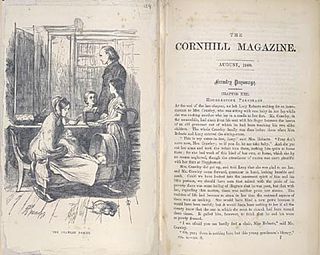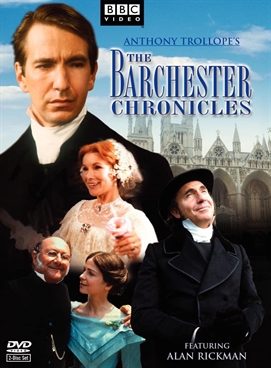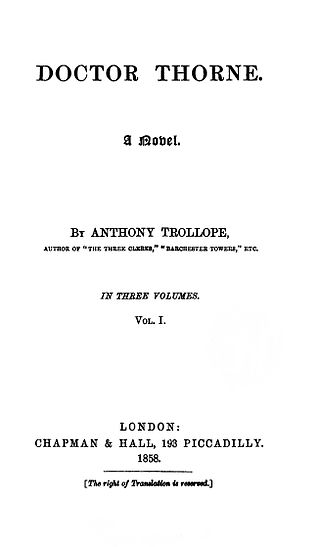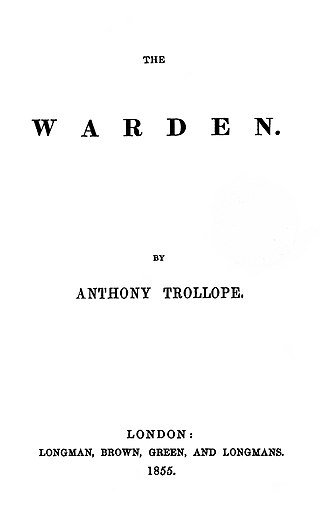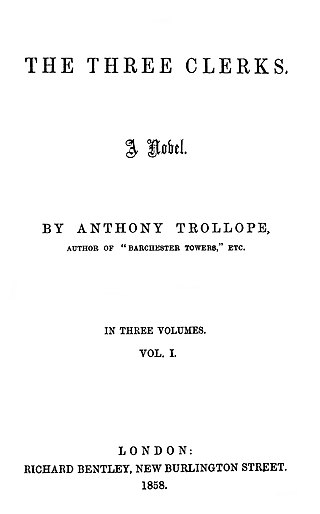Plot summary
The Warden

Mr Harding, Warden of Hiram’s Hospital, an almshouse in Barchester, is accused of enjoying an income from out of proportion to his responsibilities and the money given to the old people the Hospital houses. The accuser, a local doctor named John Bold, is actually in love with Mr Harding’s daughter, Eleanor. Nevertheless, John takes the matter to the press, subjecting Mr Harding to public criticism. Mr Harding is supported by his son-in-law, Archdeacon Grantly, who insists that he maintain his innocence. Finally, following an ultimatum from Eleanor, John drops the case and apologises. Eleanor and John get married and Mr Harding resigns as Warden of Hiram's Hospital to become Rector of St. Cuthbert's Church on a much reduced income. [6] [7] [8]
Barchester Towers
Following the death of Bishop Grantly, Dr Proudie is appointed as the new Bishop instead of Archdeacon Grantly (son of the Bishop), who had hoped for the post. Dr Proudie is supported by his imperious wife Mrs Proudie, and his chaplain, Mr Slope, both of whom want to steer the church away from traditional Anglican values. To fill the position of Warden at Hiram's Hospital, Mrs Proudie insists Mr Slope backs Mr Quiverful for the role. However, Mr Slope is infatuated with widowed Eleanor Bold, and instead secretly supports the reappointment of her father Mr Harding, as do the Archdeacon and Mr Arabin of Oxford University. Mr Slope eventually proposes to Eleanor, and in doing so, exposes his dealings with both sides. In the end, he is ostracised by the cathedral community, while Mr Arabin marries Eleanor and Mr Quiverful is appointed Warden of Hiram's Hospital. [8] [9] [10]
Doctor Thorne
After the Gresham family has taken mortgages on the Greshamsbury estate to support itself, Frank Gresham, heir to the Greshamsbury estate, is being pressed by his family to marry a woman of wealth, such as Miss Dunstable. However, Frank is in love with Mary Thorne, niece of the Greshams' family physician, Doctor Thorne. While Mary appears to have no fortune, she is actually the illegitimate niece of the millionaire Sir Roger Scatcherd, a fact known only to Doctor Thorne. Following the death of Roger and his son Louis, Mary, being the eldest niece, receives Roger’s inheritance. Despite having already consented to their marriage, Frank’s family are far more welcoming of Mary after hearing she now has the wealth to restore the estate's fortune. [8] [11] [12]
Framley Parsonage
In an attempt to make connections with high society, young vicar Mark Robarts foolishly guarantees a loan to a corrupt member of Parliament, Nate Sowerby. When Mr Sowerby does not repay the loan, Mark’s friend Lord Lufton eventually steps in and saves Robarts from financial disaster. Mark’s sister Lucy has moved to Framley and falls in love with Lord Lufton. However, Lucy rejects Lord Lufton’s proposal, knowing that his mother, Lady Lufton, would refuse to accept a woman of her status as a potential wife for her son. Lady Lufton is adamant her son should marry Griselda Grantly, daughter of the Archdeacon. However in the end, Lady Lufton changes her attitude and asks Lucy to accept her son’s proposal, after witnessing Lucy care selflessly for the poor Mrs Crawley. Meanwhile, Mrs Proudie re-ignites a feud with the Archdeacon and his wife. Another subplot features the marriage of Doctor Thorne and the wealthy Miss Dunstable, who was initially the choice of Frank Gresham’s family. [8] [13] [14]
The Small House at Allington
Sisters Bell and Lily Dale live with their widowed mother in the "Small House" in the village of Allington. The squire, Christopher Dale, wants Bell to marry his nephew Bernard, who is heir to the estate. Bernard introduces Lily Dale to Adolphus Crosbie, who later proposes to her. However upon learning that Lily Dale is not due to receive any significant inheritance, Crosbie also proposes to Lady Alexandrina of the prominent de Courcy family, leaving Lily Dale heartbroken. Upon hearing this, Johnny Eames, lifelong admirer of Lily Dale, beats up Crosbie in an act of which promotes him to local hero. Yet despite his devotion, Lily Dale, still emotionally devastated, rejects his proposal and chooses instead to live with her mother. In the end, Bell marries a local doctor. Crosbie and Lady Alexandrina marry, but their life is unhappy, and they decide to separate. [8] [15] [16]
The Last Chronicle of Barset
The main storyline follows the impoverished Rev. Josiah Crawley, introduced in Framley Parsonage, who is ostracised after being wrongly accused of stealing money. Meanwhile, Major Grantly, son of the Archdeacon, falls for the disgraced clergyman's daughter, Grace Crawley. The Archdeacon, initially objecting to the marriage, eventually consents after Mr Crawley's innocence is confirmed. John Eames continues his unsuccessful pursuit of Lily Dale, while the beloved former Warden, Mr Harding, dies of old age. Mrs Proudie also reappears, and demands that her husband, Bishop Proudie, ban Mr Crawley from holding services. However, being a proud man, Mr Crawley refuses to comply, before Mrs Proudie dies of a heart attack. [8] [17] [18]







